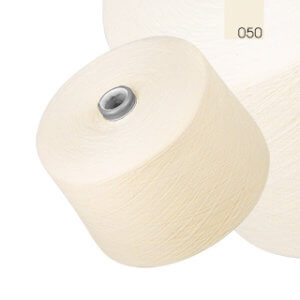Flame retardant yarn – quality.
The cotton fibers used in the yarn production process are of high quality. They come from renowned European suppliers specializing in the production of fibers for yarns used in the textile industry and in other industry sectors. Cotton fibers undergo a selection process in order to provide yarn producers with raw material possessing the highest technical parameters, i.e. such parameters that allow to combine cotton fibers with cellulose fibers. As a result, they are suitable for processing that enables to obtain special properties used later in the broadly understood industry. One of these properties is flame retardancy understood as a product self-extinguishing or preventing the spread of fire.
Cellulose fibers used in the production of yarns are chemical fibers, the basic raw material for the production of which is cellulose pulp derived from chemical treatment, mainly by exposure of the pulp of deciduous trees, reed, straw and coniferous trees such as pine, spruce to sodium hydroxide and carbon disulfide. The resultant sodium cellulose xanthogenate is dissolved in sodium hydroxide, which leads to obtaining a mass referred to as spinning viscose.
The spinning fluid obtained in this way is pumped through special nozzles, then it undergoes the coagulation process, i.e. under the influence of such a factor as sulfuric acid, the decomposition of sodium cellulose xanthogenate is effected, which leads to the formation of viscose fibers. In the production of staple fiber yarns, it is very important that, in general, cellulose fibers combine very well with cotton fibers while maintaining their properties.
Modern flame retardant yarn
Cellulose fibers have similar properties to cotton fibers but also combine with wool fibers very well. This property is used in the production of blended yarns such as the above-mentioned cotton yarn with the addition of viscose. The starting material for the production of yarns i.e. chemically obtained cellulose fibers, and in this case, viscose fibers, through their modification, give the yarn a number of additional advantages. Modified viscose cellulose fibers used in the yarn production process, have, in terms of flame retardancy, a significant impact on ignition and possibility of fire spreading on clothing, fabrics, and in the places where they are used. The flame of fire can spread very quickly, when in contact with textiles in the traditional form. The flame-retardant properties are incorporated into cellulose fibers, and thus in the yarn we offer, in the form of chemical compounds which permanently limit the possibility of ignition of products made of flame-retardant yarn.
The requirements of economic development force the application of new innovative technologies in industry. One of them is the use of flame-retardant yarns in knitting, weaving and haberdashery. Our yarns can be successfully used in the production of socks, protective gloves, flame retardant fabrics and knits, haberdashery, ropes, and in thermal insulation and sealing products. The above yarns can be supplied in ecru or in colors ordered by the customer.
